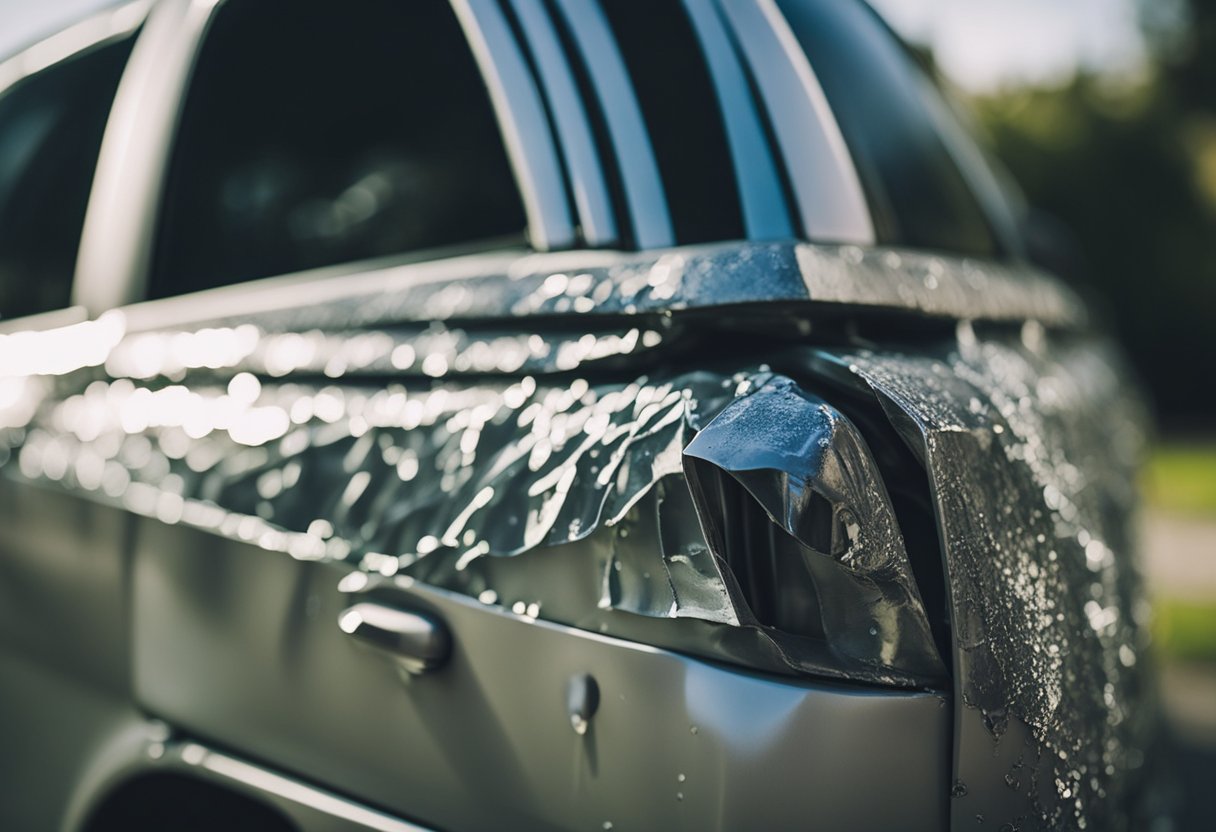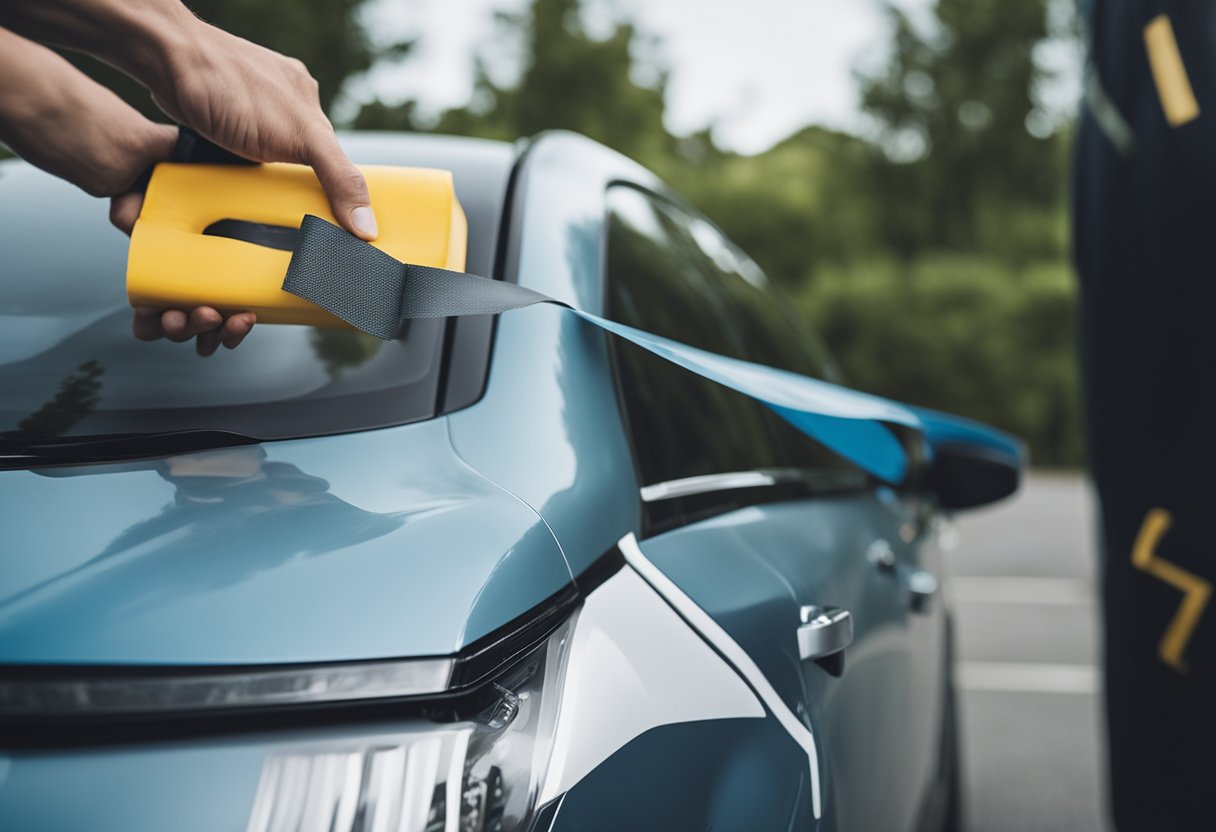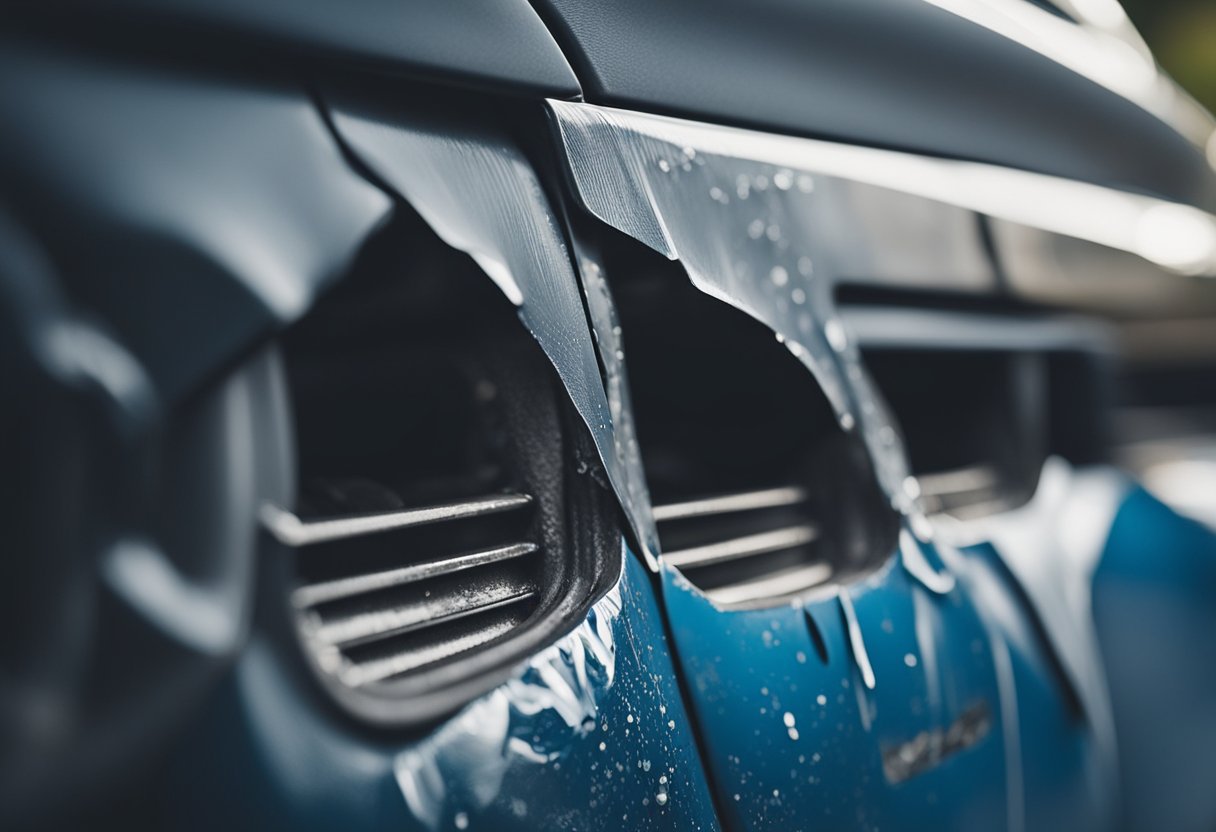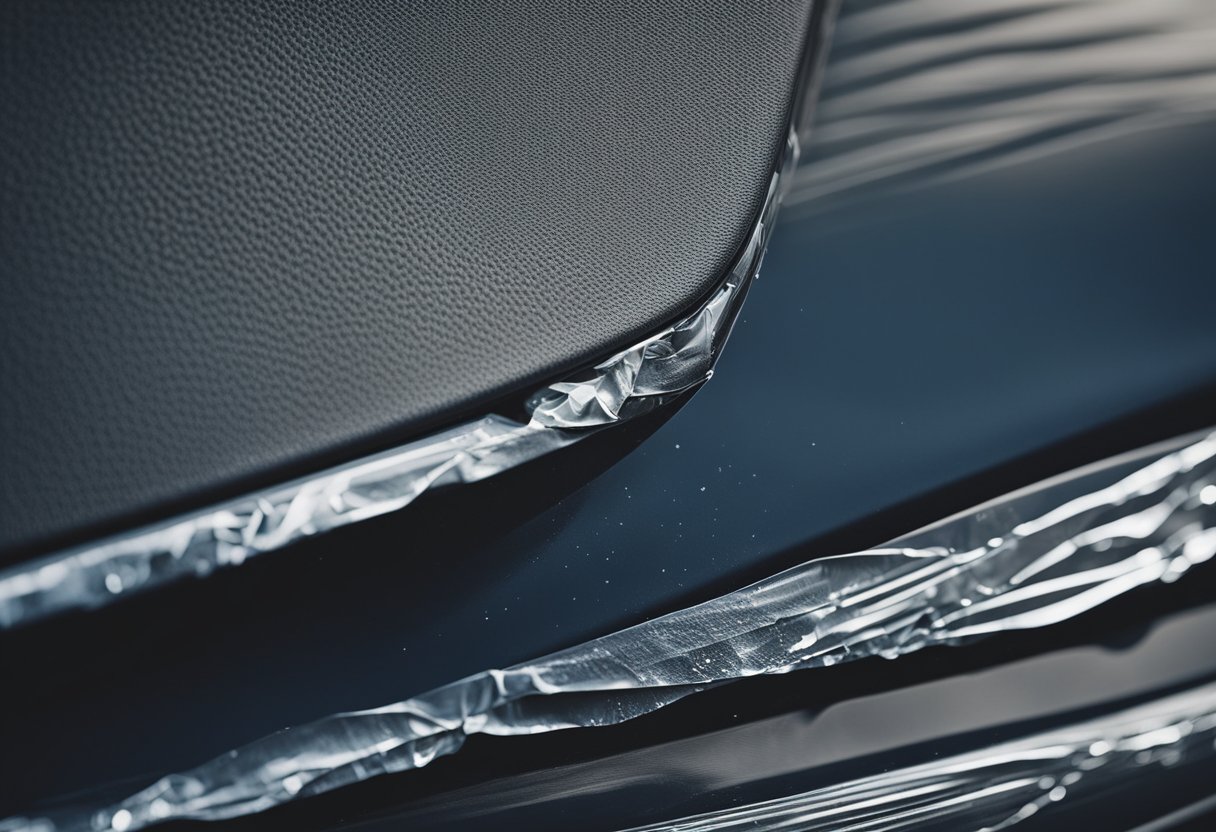I have researched the topic of “will duct tape damage car paint” and have gathered some information that will help car owners make informed decisions when using duct tape on their vehicles. Duct tape is a popular adhesive tool that can be used for temporary fixes, but it is important to understand the potential risks and proper usage to avoid damage to car paint.
Duct tape can potentially damage car paint if left on for an extended period of time, or if the paint is old and rusty. It can leave behind a sticky residue or rip off some paint. However, if used correctly and promptly removed, it should not cause any harm to the paint. It is important to take precautions to protect the paint when using duct tape on a car, and to use the right type of tape to avoid common issues.
Key Takeaways
- Duct tape can damage car paint if left on for a long time or if the paint is old and rusty, but it should not cause any harm if used correctly and promptly removed.
- Automotive masking tape is the best type of tape to use on car paint, which is gentle and easy to remove.
- It is important to take precautions to protect the paint when using duct tape on a car, and to use the right type of tape to avoid common issues.
Understanding Duct Tape and Its Adhesive Strength
As someone who has worked with cars for many years, I have seen just about everything, including the use of duct tape to hold bumpers in place, fix broken windows, and even temporarily fix minor damages. Duct tape is a popular choice for these applications because of its adhesive strength and ability to last long.
Duct tape is a type of pressure-sensitive adhesive tape that is made from a cloth or scrim material that is coated with a polyethylene or vinyl film. The adhesive used in duct tape is typically a rubber-based adhesive that is designed to stick to a variety of surfaces, including metal, plastic, and glass.
The adhesive strength of duct tape can vary depending on the type of tape used. For example, medium strength duct tape is designed to hold items weighing up to 20 pounds, while heavy-duty duct tape can hold up to 50 pounds. It is important to note that the adhesive strength of duct tape can be affected by a variety of factors, including temperature, humidity, and the type of surface it is applied to.
One thing to keep in mind when using duct tape on a car is that wet tape can cause damage to the paint. Electrical tape is a better choice for use on cars because it is designed to be used in wet environments and is less likely to damage the paint.
In conclusion, duct tape can be a useful tool for temporary repairs on a car, but it is important to use it correctly and take precautions to protect the paint.
Duct Tape Interaction with Car Paint
https://www.youtube.com/watch?v=GAYKAYyeevg&embed=true
As a professional detailer, I have come across several instances where people have used duct tape to hold car bumpers in place, as a temporary fix for broken windows, or during paint correction. While duct tape is popular for its adhesive strength and ability to last long, it is important to understand how it interacts with car paint.
Duct tape can potentially damage car paint if left on for an extended period of time. The adhesive on the tape can react with the surface of the car paint, causing it to peel off when the tape is removed. This can leave unsightly marks or even expose the bare metal beneath. Additionally, the residue left behind by duct tape can be difficult to remove, requiring additional cleaning or even professional detailing to restore the car’s appearance.
It is essential to note that the extent of the damage caused by duct tape depends on several factors, including the type of car paint, the duration the tape was left on, and the environmental conditions. For instance, if the car was exposed to high temperatures or direct sunlight, the adhesive on the tape may have reacted more aggressively with the car paint, causing more damage.
To avoid damage to your car’s paint, it is advisable to use duct tape sparingly and only for temporary fixes. If you must use duct tape, ensure that it is removed promptly and correctly. Use a plastic scraper or your fingers to peel off the tape gently, taking care not to damage the car’s paint. You can also use a hairdryer to warm up the tape, making it easier to remove without damaging the paint.
In conclusion, while duct tape is a popular tool for temporary fixes, it can potentially damage your car’s paint. It is essential to use it sparingly and remove it promptly and correctly to avoid any damage to the car’s appearance.
Potential Risks of Using Duct Tape on Car Paint
As a car owner, you might find yourself in a situation where you need to use duct tape on your car. While duct tape is a versatile tool that can be used for many purposes, it can pose potential risks to your car’s paint if not used correctly.
One of the most significant risks of using duct tape on car paint is the possibility of scratches. Duct tape has a strong adhesive that can cause scratches on the paint surface, especially if the tape is removed improperly. To avoid scratches, it is essential to apply the duct tape gently and remove it carefully.
Another potential risk of using duct tape on car paint is peeling paint. If the duct tape is left on for an extended period, it can cause the paint to peel off. The adhesive on the duct tape can react with the paint, causing it to break down and peel away. This can result in unsightly patches on the car’s surface and may require expensive repairs.
It is also important to note that the risks of using duct tape on car paint can vary depending on the type of tape used. Some types of duct tape may be more abrasive than others, causing more damage to the paint surface. Therefore, it is crucial to choose the right type of tape for the job and ensure that it is safe for use on car paint.
In conclusion, while duct tape can be a useful tool for temporary fixes on your car, it is essential to use it with caution. The potential risks of using duct tape on car paint include scratches, peeling paint, and other forms of damage. To avoid these risks, it is crucial to apply the tape gently, remove it carefully, and choose the right type of tape for the job.
Proper Removal of Duct Tape from Car Paint
https://www.youtube.com/watch?v=S9fdBA4PHSM&embed=true
As we have discussed earlier, duct tape can leave behind a sticky residue that can be difficult to remove from car paint. However, there are several ways to remove duct tape from car paint without damaging the paint job.
One of the easiest ways to remove duct tape residue is to use rubbing alcohol. Simply apply a small amount of rubbing alcohol onto a soft rag and gently rub the residue until it comes off. You can also use alcohol wipes if you have them on hand.
Another effective method is to use Goo Gone. This product is specifically designed to remove sticky residue from various surfaces, including car paint. Apply a small amount of Goo Gone onto a soft rag and gently rub the residue until it comes off.
If the residue is particularly stubborn, you can use a plastic scraper to gently scrape it off. Be sure to use a plastic scraper rather than a metal one to avoid scratching the paint. You can also use a hair dryer to heat up the residue, making it easier to scrape off.
WD-40 is another product that can be used to remove duct tape residue from car paint. Apply a small amount of WD-40 onto a soft rag and gently rub the residue until it comes off. However, be sure to wash the area thoroughly with soap and water after using WD-40 to avoid any damage to the paint.
Nail polish remover can also be used to remove duct tape residue. Apply a small amount of nail polish remover onto a soft rag and gently rub the residue until it comes off. However, be sure to test the nail polish remover on a small, inconspicuous area of the car first to ensure that it does not damage the paint.
Once the residue has been removed, be sure to wash the area thoroughly with soap and water and dry it with a microfiber cloth. This will help to remove any remaining residue and protect the paint from any potential damage.
In conclusion, there are several ways to remove duct tape residue from car paint without damaging the paint job. Whether you choose to use rubbing alcohol, Goo Gone, a plastic scraper, WD-40, or nail polish remover, be sure to test the product on a small, inconspicuous area of the car first to ensure that it does not damage the paint.
Dealing with Residue: Post Duct Tape Removal
https://www.youtube.com/watch?v=E6Jdy-7oshc&embed=true
After removing the duct tape from your car, you may notice some residue left behind. This residue can be unsightly and difficult to remove, but there are several ways to deal with it.
One option is to use an adhesive remover. These products are specifically designed to dissolve adhesive residue and make it easier to wipe away. Be sure to follow the instructions carefully and test the product on a small, inconspicuous area of your car before using it on a larger area.
Another option is to use acetone. Acetone is a powerful solvent that can dissolve many types of adhesives. However, it can also damage some types of paint, so it’s important to be careful when using it. Apply a small amount of acetone to a clean cloth and gently rub the residue until it dissolves. Be sure to rinse the area thoroughly with water and dry it with a clean cloth.
If you don’t have any adhesive removers or acetone on hand, you can try using car wash soap. Simply apply a small amount of soap to a clean cloth and gently rub the residue until it comes off. Be sure to rinse the area thoroughly with water and dry it with a clean cloth.
It’s important to note that different types of duct tape may leave behind different types of residue. Some may be more difficult to remove than others. If you’re having trouble removing the residue, you may want to consider taking your car to a professional detailer.
In conclusion, dealing with residue left behind after removing duct tape from your car can be a hassle, but there are several options available to make the process easier. Whether you choose to use an adhesive remover, acetone, or car wash soap, be sure to follow the instructions carefully and test the product on a small area before using it on a larger area.
Alternatives to Duct Tape for Temporary Fixes
When it comes to temporary fixes for cars, duct tape is often the go-to solution. However, if you’re worried about potential damage to your car’s paint, there are plenty of alternatives to consider. Here are a few options:
Painter’s Tape
Painter’s tape is a low-adhesive tape that is designed to be used on surfaces without leaving any residue. It’s a great option for temporary fixes because it won’t damage your car’s paint. Plus, it comes in a variety of widths, so you can choose the size that’s right for your needs.
Automotive Masking Tape
Automotive masking tape is designed to be used on cars, so it’s a great option for temporary fixes. It’s easy to tear by hand, and it won’t leave any residue on your car’s paint. Plus, it’s designed to withstand high temperatures, so it won’t melt or lose its adhesive properties in hot weather.
Office Tape
If you’re in a pinch and don’t have any other tape on hand, office tape can be used as a temporary fix. However, it’s important to note that it may not be as strong as other types of tape, and it may leave residue on your car’s paint.
Packing Tape
Packing tape is another option for temporary fixes, but it’s important to choose a high-quality tape that won’t damage your car’s paint. Look for a tape that is designed to be used on surfaces without leaving any residue.
Vinyl Tape
Vinyl tape is a strong, durable tape that is designed to be used on a variety of surfaces. It’s a great option for temporary fixes because it won’t damage your car’s paint. Plus, it’s available in a variety of colors, so you can choose a tape that matches your car’s paint.
Colored Duct Tape
If you’re looking for a tape that is similar to duct tape but won’t damage your car’s paint, colored duct tape is a good option. It’s available in a variety of colors, so you can choose a tape that matches your car’s paint. However, it’s important to note that it may not be as strong as traditional duct tape.
Gaffer Tape
Gaffer tape is a strong, durable tape that is designed to be used on a variety of surfaces. It’s a great option for temporary fixes because it won’t damage your car’s paint. Plus, it’s available in a variety of colors, so you can choose a tape that matches your car’s paint.
Yellow Automotive Masking Tape
Yellow automotive masking tape is designed to be used on cars, so it’s a great option for temporary fixes. It’s easy to tear by hand, and it won’t leave any residue on your car’s paint. Plus, it’s designed to withstand high temperatures, so it won’t melt or lose its adhesive properties in hot weather.
Precautions to Consider When Using Duct Tape on Cars
As I mentioned earlier, duct tape can potentially damage car paint if left on for an extended period of time. Therefore, it is important to take precautions when using duct tape on cars. Here are some precautions to consider:
1. Avoid using duct tape on hot surfaces
Duct tape can lose its adhesive properties when exposed to high temperatures. Therefore, it is advisable to avoid using duct tape on hot surfaces. If you must use duct tape on a hot surface, wait for it to cool down before applying the tape.
2. Clean the surface before applying duct tape
Dirt, dust, and moisture can prevent duct tape from adhering properly to the surface. Therefore, it is important to clean the surface before applying duct tape. You can use warm water and a mild detergent to clean the surface. Make sure to dry the surface thoroughly before applying the tape.
3. Remove the tape promptly
As I mentioned earlier, duct tape can damage car paint if left on for an extended period of time. Therefore, it is important to remove the tape promptly once you no longer need it. To remove the tape, you can use warm water and a soft cloth. Make sure to avoid using any abrasive materials that can scratch the surface.
4. Use protective coatings
If you are using duct tape on a car that has a protective coating, it is important to avoid damaging the coating. Therefore, it is advisable to use a protective coating such as wax or sealant before applying the tape. This will help protect the coating from any potential damage.
5. Avoid using duct tape on fabric surfaces
Duct tape can leave a sticky residue on fabric surfaces. Therefore, it is important to avoid using duct tape on fabric surfaces such as car seats or carpets. If you must use duct tape on a fabric surface, make sure to remove it promptly and clean the surface thoroughly to remove any residue.
By following these precautions, you can use duct tape on cars without causing any damage to the paint or other surfaces.
Impact on Car Value and Appearance
As a car owner, one of the primary concerns when using duct tape on a car is its impact on the vehicle’s appearance and value. While duct tape can be versatile and useful in many automotive applications, it can also cause damage to the car’s paint if left on for an extended period of time.
When duct tape is used to hold car bumpers or other parts in place, it can leave behind adhesive residue that is difficult to remove. This residue can cause the paint to peel or become discolored, which can negatively impact the car’s appearance and reduce its resale value.
Furthermore, if the duct tape is not removed promptly, it can cause more severe damage to the car’s paint, requiring costly repairs. It is important to note that the damage caused by duct tape is not limited to the exterior of the car, as the adhesive can also seep into the interior and cause damage to the upholstery.
To prevent damage to the car’s appearance and value, it is recommended to use duct tape only as a temporary fix and to remove it as soon as possible. Additionally, it is important to use the correct type of tape for automotive use, such as painter’s tape, which is designed to be gentle on surfaces and easy to remove.
In summary, while duct tape can be a useful tool in automotive repairs, it is important to use it with caution and be mindful of its potential impact on the car’s appearance and value. By using the correct type of tape and removing it promptly, car owners can avoid costly repairs and maintain the overall quality of their vehicle.
Frequently Asked Questions
What kind of tape is safe for car paint?
When it comes to taping on car paint, it is always best to use a tape that is safe for automotive use. Some of the tapes that are safe for car paint include automotive masking tape, vinyl wrap tape, and low-tack painter’s tape. These tapes are specifically designed to be gentle on car paint and should not cause any damage when removed.
Can blue painters tape damage car paint?
Blue painter’s tape is a type of masking tape that is commonly used in painting projects. While it is generally safe to use on car paint, it is important to note that leaving it on for an extended period of time can cause damage to the paint. It is recommended to remove the tape as soon as possible after use to avoid any potential damage.
How to remove duct tape residue from car dashboard?
Removing duct tape residue from a car dashboard can be tricky, but there are a few methods that can help. One way is to use a solution of warm water and dish soap to gently scrub the residue away. Another option is to use a commercial adhesive remover, such as Goo Gone, which is safe for use on car surfaces. It is important to always test any cleaning solution on a small, inconspicuous area first to ensure that it does not cause damage to the dashboard.
Will duct tape rip off car paint?
Duct tape can potentially rip off car paint if left on for an extended period of time or if the paint is already damaged or weakened. It is important to always use caution when applying duct tape to a car surface and to remove it as soon as possible after use.
Can you put duct tape on your car without damaging the paint?
While duct tape can potentially damage car paint if left on for an extended period of time, it is generally safe to use for temporary fixes or quick repairs. It is important to always use caution when applying duct tape to a car surface and to remove it as soon as possible after use.
Is Goo Gone safe for removing duct tape residue from car paint?
Goo Gone is a commercial adhesive remover that is safe for use on car surfaces, including car paint. It is important to always follow the manufacturer’s instructions when using Goo Gone or any other cleaning solution on a car surface to avoid any potential damage.

Hi, I’m Sal Muller of Tooltrip.com. My DIY experience led me to understand essential power tools for home projects. Tooltrip.com guides enthusiasts and professionals in choosing right tools for any job. I provide concise top tool reviews for easier, efficient DIY.








